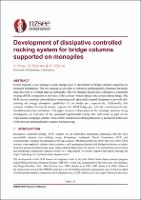| dc.contributor.author | Piras, Sabina | |
| dc.contributor.author | Palermo, Alessandro | |
| dc.contributor.author | Chiaro, Gabriele | |
| dc.date.accessioned | 2021-06-22T04:01:56Z | |
| dc.date.available | 2021-06-22T04:01:56Z | |
| dc.date.issued | 2021-04-14 | |
| dc.identifier.uri | https://repo.nzsee.org.nz/xmlui/handle/nzsee/2376 | |
| dc.description.abstract | In this research, a low-damage seismic design detail is developed for bridge columns supported on monopile foundations. The low-damage system aims to minimise, and potentially eliminate, the repair time and costs to a bridge after an earthquake. The low-damage design uses a dissipative controlled rocking (DCR) connection at the base of the column, which replaces the column plastic hinge. The DCR system combines unbonded post-tensioning and replaceable internal dissipaters to provide self-centring and energy absorption capabilities for the bridge pier, respectively. Additionally, this research validates the lateral seismic response of a DCR bridge pier with the contribution of soil-foundation-structure interaction. This paper includes a description of the prototype structure being investigated, an overview of the proposed experimental testing that will occur as part of the experimental campaign, and the results of the numerical modelling that aims to predict the behaviour of the protype and benchmark structure during testing. | |
| dc.language.iso | en | |
| dc.publisher | New Zealand Society for Earthquake Engineering | |
| dc.relation.ispartofseries | 2021;0026 | |
| dc.subject | Improving resilience of lifelines and infrastructure | |
| dc.subject | Innovative approaches in seismic design and assessment | |
| dc.title | Development of Dissipative Controlled Rocking Bridge Columns on Monopile Foundations | |
| dc.type | Article | |

